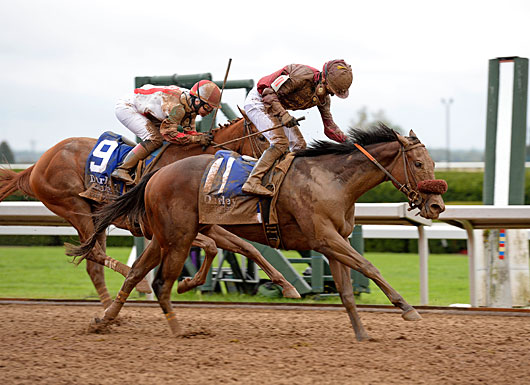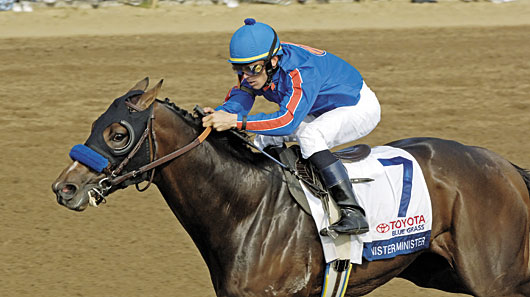While I’ve seen a few days where the dirt track has suggested a moderate level of bias either way, the new dirt surface at Keeneland generally has been fair and certainly has not produced the dramatic speed-favoring bias the former dirt track would sometimes display.
Granted, the new track has only offered nine race days but my general assessment would be that it is similar to other North American dirt tracks where it’s difficult to rally from too far back. In my eyeball look through the past performance charts, I’ve only noticed one horse who rallied from last early to win a race on the dirt track at the current fall meet. (I didn’t use the computer on this study; hopefully I didn’t miss anyone.)
That single horse to rally from last was Tellalittlesecret who rallied from ninth to win a 1 1/16-mile claiming race on Oct. 5. Two-turn races that day seemed to favor mid-pack closers, so the move was not too far out of line with the trend that day. (Honorable mention in this category goes to Peace and War, who rallied from 11th, 13 ¾ lengths back a half-mile into the race, to win the 1 1/16-mile Darley Alcibiades Stakes [gr. I]. Again though, that was on a day that horses were making moves in the two-turn races.).

Peace and War rallied from 11th to win the Darley Alcibiades Stakes - Anne M. Eberhardt Photo
While it’s difficult to close from far back at many U.S. tracks, the reason the former dirt track at Keeneland could be frustrating is that even horses tracking the leader would sometimes spin their wheels as they tried to make a move to the front.
Perhaps the most memorable of horses to thrive under the former dirt conditions was Sinister Minister, who led every step and drew off to a 12 3/4-length win in the 2006 Toyota Blue Grass Stakes (gr. I) in the final meet before Polytrack was installed. Sinister Minister's only win before that triumph was in a maiden-claiming race and he would never win again in eight starts after the Blue Grass. (In fairness, horses were rallying on the dirt that April day, including winners who raced sixth and 11th early. The Blue Grass was the only two-turn dirt race that day, so perhaps that factored. I did think the speed-favoring effect on the former Keeneland dirt track often played more prominently in the two-turn races ... moving on though.).

Sinister Minister won the 2006 Toyota Blue Grass Stakes by 12 3/4 lengths - Anne M. Eberhardt Photo
At the new dirt track, horses have been able to track early and then make a move at the leader.
This running type, which BrisNet PPs list as EP, would be the preferred running style in one-turn races so far at Keeneland, with horses rated as PE being next. In other words, horses shadowing the front runner to about two lengths back are faring well in the one-turn races. I would say this is fairly standard at most North American dirt tracks.
In two-turn races, horses from a bit further back early, presser to mid-pack closer, have fared well--say four or five lengths back in racing positions in the middle of the field.
It most assuredly has been worth separating the one-turn races and the two-turn races at Keeneland in looking for any bias trends. On opening day for instance, I rated the favored early running style as E/EP (runners on or near the pace) for one-turn races but SP (back of pack) for two-turn races.
That said, there have been three horses to lead at first call and win two-turn races at the meet and four horses to rally from mid-pack or further back early to win sprint races. All in all, it’s been a fair track to this point.




